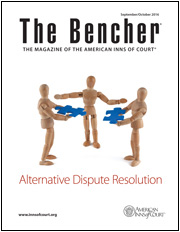To Err is Human—To Err Again May be a Violation of Rule 1.1 and 1.6
The Bencher—September/October 2016
By Richard K. Herrmann, Esquire

 The experts opine that mediation requires more than one party. I disagree. In fact, I would like to facilitate a compromise that you should make with yourself going forward. Remember a successful mediation means you have to bleed a little. In this case, I want you to give up a little convenience for a lot of risk.
The experts opine that mediation requires more than one party. I disagree. In fact, I would like to facilitate a compromise that you should make with yourself going forward. Remember a successful mediation means you have to bleed a little. In this case, I want you to give up a little convenience for a lot of risk.
How many of you have had a near death experience because of an e-mail mistake? We all have, and those of you who haven’t are likely in denial. Our business culture has evolved to the extent we have made a proverbial deal with the devil, to wit, “I know it’s risky but it’s so damned convenient.” Of course, the efficiency saved by taking the risk amounts to seconds for any one e-mail, certainly nothing that will appear as a benefit on a client’s invoice. When it comes to certain common e-mail risk we simply refuse to play it safe.
Let’s focus on the low hanging fruit, those risks that are clearly avoidable. They fall into the following buckets (1) auto-complete in the address field, (2) bcc.
Auto-Complete in the Address Field
We all use this wonderful feature. We begin typing a few letters and Outlook completes the e-mail address, based on information in recent memory or your contacts list. It is very convenient; however, it is not always correct. The most extreme example relates to a lawyer at a large Philadelphia firm working on behalf on Eli Lilly and intending to e-mail confidential information concerning a huge anti-trust settlement to her co-counsel named, Berenson. Unfortunately, she had two Berenson’s in her contacts list and Outlook chose the wrong one, a reporter for The New York Times. http://abovethelaw.com/2008/02/atl-practice-pointer-when-emailing-super-sensitive-settlement-information-double-check-the-recipient-list/
How often do you send an e-mail to a lawyer who you know has changed firms but your auto-complete still has him at his old e-mail address? That is exactly what happened when a lawyer in Massachusetts sent an e-mail to his client who left his old engineering firm to compete. The former employer and its attorneys tried to exploit the ill-gotten communication. The court found that intentional misuse of inadvertently disclosed confidential information trumped the inadvertency. https://apps.americanbar.org/litigation/litigationnews/top_stories/031611-inadvertent-disclosure-ethics.html
PRO TIP: Deactivate auto-complete in Outlook
Bcc (Blind carbon copy)
Let’s put aside the question from the millennials who have never personally touched a typewriter, let alone carbon paper. In the high tech parlance of today’s digital age, “bcc” in Outlook still refers to blind carbon copy. This is a very convenient function, just as it always has been. Of course, “back in the day” when a client received a bcc of a letter to opposing counsel, if the client wanted to discuss the contents, he would write a letter or pick up the phone. In today’s world, the client simply clicks “reply”, unless he inadvertently clicks on “reply to all”. And we all know the result—an intended confidential communication inadvertently sent to opposing counsel and anyone else on the cc (carbon copy) list. You might think this kind of hypothetical is a bit esoteric and unlikely to really occur. Well, you would be wrong. Fortunately for the client, the judge followed the “one bite rule” in Charm v. Kohn, 27 Mass. L. Rep. 421, 2010 Mass. (Mass. Super. Sept. 30, 2010). (Actually, it was the two bite rule since the client had made the same mistake previously). In finding it a close call but that no waiver had occurred, the court noted:
Kohn and his counsel should not expect similar indulgence again. They, and others, should take note: Reply all is risky. So is bcc. Further carelessness may compel a finding of waiver.
Of course, you may say, the mistake was the client’s and not the attorney’s. The court observed this as well; but the court pointed out counsel chose the manner of communication with the client. Think about this when you reread Rule 1.1 since, as the court in Kohn observed:
Kohn’s counsel’s practice of sending him a bcc of e-mails to opposing counsel, with a cc to co-counsel, gave rise to a foreseeable risk that Kohn would respond exactly as he did.
PRO TIP: DO NOT BCC
Of course, had the client not selected “reply to all” there would have been no issue. But we all use “Reply to all” and we should not. “Reply to all” is a topic for another day.
Richard K. Herrmann, Esquire is a partner in the firm of Morris James in Wilmington, Delaware. He is a Master in the Richard K. Herrmann Technology AIC.
© 2016 Richard K. Herrmann, Esq. This article was originally published in the September/October 2016 issue of The Bencher,
a bi-monthly publication of the American Inns of Court. This article,
in full or in part, may not be copied, reprinted, distributed, or stored
electronically in any form without the express written consent of the American Inns of Court.